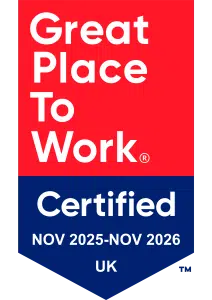The connection between employee experience and customer experience

The link between CX and EX isn’t theoretical. Every interaction a customer has with a brand is indirectly shaped by how employees feel about their work. A motivated, engaged team brings energy and problem-solving instincts. A disengaged team, on the other hand, simply delivers the bare minimum. It’s a risk for retention – and quietly erodes brand reputation.
Why employee experience shapes customer experience
We tend to separate CX and EX as if they operate in different silos. They don’t. Think about the last time you encountered exceptional service: maybe a shop assistant went above and beyond, or a support agent solved a problem before you even asked. That level of care doesn’t come from rigid scripts; it comes from employees who feel trusted and empowered.
If employees are overworked, lacking resources or caught in layers of bureaucracy, customers feel that tension too. It shows up in delayed responses, apathetic tones and missed details. Not only is EX a factor in day-to-day customer interactions, but it also influences innovation. Teams that enjoy a positive environment are more likely to experiment and find creative solutions that push CX forward.
There’s also the hard data. Studies repeatedly show that companies investing in EX – clear communication, career growth and meaningful recognition – tend to outperform competitors in customer loyalty metrics. It’s not magic. Happy employees treat customers the way they want to be treated themselves.
Where the connection breaks down
Here’s the tricky part: many businesses focus on CX initiatives while ignoring internal friction. They invest in shiny apps for customers then neglect the outdated tools their teams use daily. Or they introduce “customer-first” policies without giving employees the flexibility to make them work in the real world.
The company culture might say all the right things on paper, but the reality doesn’t match. When you don’t deliver on the promises of career development or flexibility, employees disengage. And disengaged employees don’t create remarkable customer experiences – they simply follow the checklist.
That’s why shaping values into everyday behaviours is critical. A strong workplace culture isn’t a list of principles buried in an HR document; it’s how people act, solve problems and collaborate when no one’s watching. When culture and experience align internally, customers instantly feel the difference.
How to strengthen CX and EX
CX and EX are two sides of the same coin – and the most successful organisations approach them as such. It’s not about separate strategies but a shared philosophy: treat employees with the same care you want customers to feel.
Here’s a few high-impact areas to focus on:
- Empowerment: Give employees the autonomy to solve problems without needing five layers of approval. This builds confidence, and translates into faster, more personal customer service
- Training and tools: Well-trained staff armed with intuitive tools create smoother customer interactions. Outdated systems lead to errors and frustration – for both sides
- Feedback loops: Employees are the front line. If they can share customer insights freely and see them in action, they become active contributors to improving CX
- Recognition and growth: Recognition motivates and reinforces a culture where doing right by customers is celebrated, not just expected.
These areas bridge the gap between a satisfied team and a satisfied customer base. But they only work if leadership fully commits to both experiences, rather than favouring one or the other.
The culture question
Culture can make or break your CX and EX. You can invest in training, perks and fancy software, but if the culture is toxic, results will be superficial at best. Building a people-first company culture means employees aren’t cogs in a machine – they have space to thrive, contribute and question.
Of course, culture is a long game. You can’t fix it with a one-off workshop or a quarterly survey. It’s embedded in how you make decisions, how leaders communicate and how you handle failures. Companies that understand this don’t just react to issues – they proactively create an environment where employees and customers feel equally valued.
And here’s where the ripple effect kicks in. A strong EX leads to positive word of mouth – among customers and prospective employees. That’s a cycle you want to keep, because talent and customer trust are hard to earn and easy to lose.
The bottom line
The connection between CX and EX isn’t optional – it’s structural. Every customer touchpoint is, at its core, powered by employees’ energy, skills and attitudes. Ignoring EX while trying to polish CX is like decorating a house while the foundations crumble.
To build long-term customer loyalty, companies must invest in both. Listen to employees, refine culture and carefully consider promises to staff – are as carefully as promises to your customers. When the two experiences are aligned, the results are powerful: happier teams, more satisfied customers and a brand that feels genuinely human.
